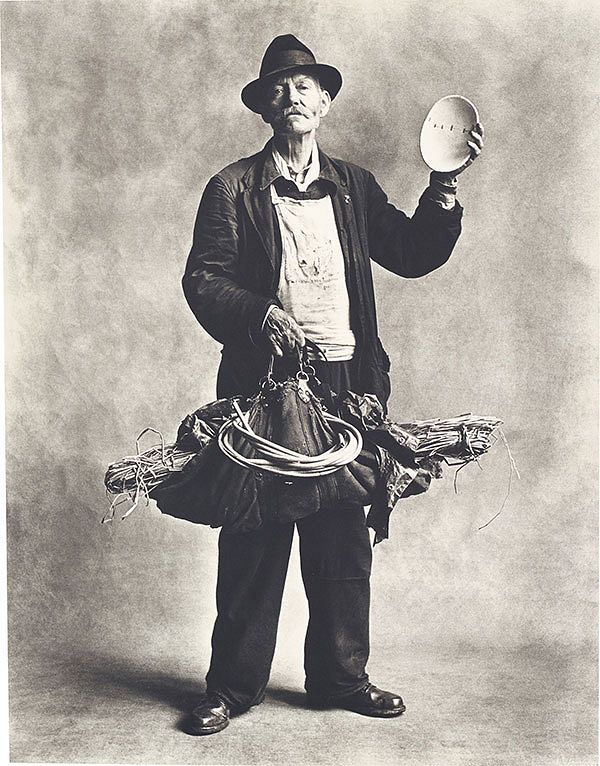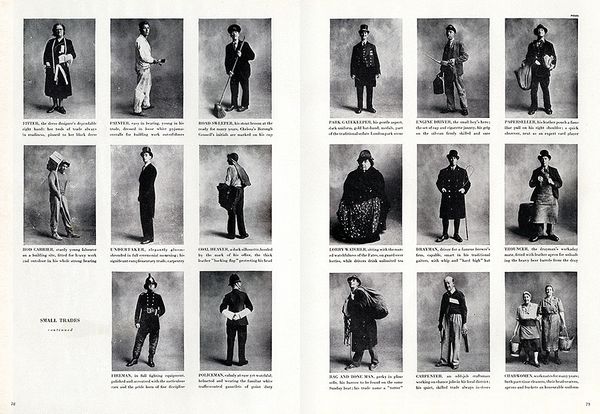Penn’s London Small Trades in Vogue Britannica, February 1951. Credit: Condé Nast.
ULTIMATE IRVING PENN showcases a carefully curated selection of 10 exceptional platinum-palladium prints from master photographer Irving Penn’s iconic Small Trades series. Taken in 1950-51 and self-printed in 1967 — the year in which Penn perfected the platinum-palladium process — these long sold-out works have been in the same private collection for over a decade and are appearing at auction for the first time. The extraordinary calibre of these 10 featured works is a testament to Penn’s standing as one of the most acclaimed artists of the 20th century.
In September of 1950, Irving Penn traveled to London after a summer in Paris spent photographing tradespeople for the developing Small Trades project. The collection of full-length portraits, taken in Paris, London, and New York, depicts everyday workers with the clothes and tools of their trades. Collectively, the images invoke and update the centuries-old printmaking tradition known as small trades, street cries, or petits métiers. While Eugène Atget’s portraits of tradesmen at the turn of the century and the social documentary work of Walker Evans were also key influences, Penn chose to isolate the subject in the neutral space of his studio over the vernacular setting of the street. Penn’s studio, with its signature mottled gray backdrop, provided a timelessness to each portrait. His sitters were encouraged to occupy the space as they pleased, allowing their personalities to emerge under Penn’s patient eye. "Taking people away from their natural circumstances and putting them into the studio in front of a camera did not simply isolate them, it transformed them," said Penn.
While in London, Penn began to notice a difference in attitude between workers in each city, stating, “The Parisians doubted that we were doing exactly what we said we were doing … but they came to the studio more or less as directed — for the fee involved. But the Londoners were quite different from the French. It seemed to them the most logical thing in the world to be recorded in their work clothes. They arrived at the studio, always on time, and presented themselves to the camera with a seriousness and pride that was quite endearing.” Twenty-four of these London photographs were published in the February 1951 issue of Vogue Britannica, in an article also titled “Small Trades,” which began with a question: “What is the smallest component part, the unchanging eternal element in the life of England? The butcher, the baker, the candle-stick maker … the man we know so well we take him for granted, the artisan, the tradesman, the man with a craft which he has perfected throughout his life.” The photographs were accompanied by individual captions; the one for Engine Driver read, “The small boy’s hero; the set of cap and cigarette jaunty, his grip on the oil can firmly skilled and sure.”

Irving Penn, Tinker, London, 1950. © The Irving Penn Foundation. Photographs London.
Penn returned to New York that autumn and continued work on Small Trades into the first half of 1951. He observed further that the workers in New York responded differently to being photographed than did their counterparts in London and Paris. “In spite of our cautions,” Penn said, “a few arrived for their sittings having shed their work clothes, shaved, even wearing dark Sunday suits, sure this was their first step on the way to Hollywood.” The New York portraits were published in the July 1951 edition of American Vogue as a 12-page portfolio to accompany an essay titled “America, Inc.: A Gallery of the Unarmed Forces”.
Taking people away from their natural circumstances and putting them into the studio in front of a camera did not simply isolate them, it transformed them.
— Irving Penn

Penn’s New York Small Trades in American Vogue, July 1951. Credit: Condé Nast.
After publishing the Small Trades photographs in the pages of French, British and American Vogue, Penn embarked on a multiyear research project to learn about platinum printing, a popular process at the turn of the 20th century on account of its rich tonal range and fine detail. He had become dissatisfied with the way in which his photographs appeared in magazines, describing the print as a “thing in itself, not just a halfway house on the way to the page.” Penn’s experiments led him to the platinum-palladium process, which enabled the photographer to create prints with remarkable subtlety, richness of tone and sensuous textures that were dramatically different from glossy gelatin silver prints. A meticulous craftsman, Penn mixed, coated, exposed and developed all the platinum-palladium prints himself, reveling in his newfound ability to manipulate each image to his liking. Perfecting his technique in 1967, he reprinted his Small Trades portraits in platinum-palladium, imbuing warmth to his subjects and transforming the images into luminous works of art. Throughout his career, Penn remained deeply interested in the printing process and the many ways in which a single negative can be rendered.
In 2008, Penn spoke with the deepest respect and empathy for the daily lives of working men and women, describing his Small Trades photographs as “residual images of enchantment.” The transformation of the Small Trades from their original magazine appearance to their rigorous reinterpretation as platinum-palladium prints reflects Penn’s own career from Vogue photographer to one of the most influential artists of his generation. Since the creation of Small Trades, most of these professions have all but vanished, ensuring the legacy of Penn’s emblematic series not only as a major artistic achievement but also as a historical record of our civilization.
Discover More from Photographs London >
Recommended Reading
Promethean Figures: Peter Beard and Francis Bacon, 1976 >
A Mapping of the Self: Photographs from the Collection of Peter McLeavey >
